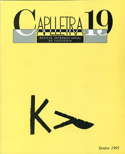El tamp en valencià
DOI:
https://doi.org/10.7203/caplletra.19.7375Keywords:
morfologia, tamp, valencià Abstract
Abstract
This essay intends to apply to the Valencian verb the linguistic method of TAMP (tense-aspect-mood-person) within which different pragmatic parameters are organized in such a way never before seen to better understand this phenomena. The basic theory that this application shows is the Topological-Natural Pragmatics (T-NP, Calvo 1989) in which the tense-aspect relationship is dominated by the super-structural mood-person relationship. In this way, a new verbal paradigm is offered to explain the necessity of the past periphrastic or of the marked first person of the present indictive.
The explanation of TAMP in Valencian is based in morphology, since there exists morphems which characterize it: stress (—'(—), —(—')), aspect (-av-I-i-), mood (- Vr-) and supermood (-Vs-). When the morphems do not appear, the result is a general background that permits different verbal uses and their neutralizations.
 Downloads
Downloads
Downloads
Published
How to Cite
-
Abstract411
-
PDF (Català)104
Issue
Section
License
Authors submitting work to Caplletra for publication must be the legitimate holder of the usage rights. Legitimacy for the purposes of publishing the work must also include images, tables, diagrams and any other materials that may complement the text, whether they are the author of such material or not.
Copyright: on publishing their work in the journal, the author grants Caplletra. Revista Internacional de Filologia usage rights (reproduction, distribution and public communication) for both the paper printed version and for the electronic version.
All work published in Caplletra is covered by the Creative Commons license type Attribution-NonCommercial-NoDerivatives 4.0 (CC BY-NC-ND 4.0).
RESPONSABILITY
Caplletra. Revista Internacional de Filologia does not necessarily identify with the points of view expressed in the papers it publishes.
Caplletra. Revista Internacional de Filologia accepts no responsibility whatsoever for any eventual infringement of intellectual property rights on the part of authors.






